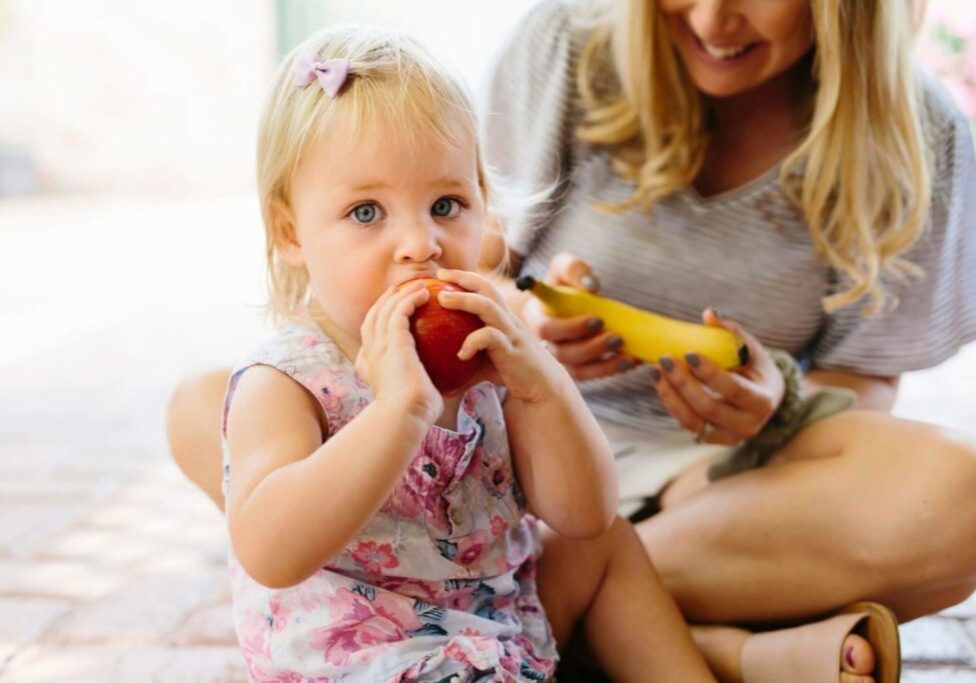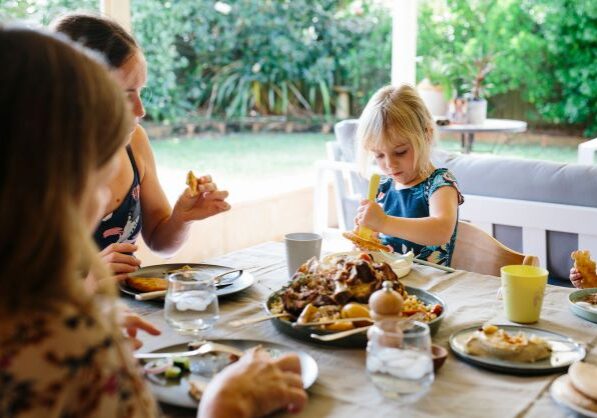School Mealtimes
We  Early Childhood Educators
Early Childhood Educators
We know that teachers want the best outcomes for their students. We appreciate that schools and childcare centres are dedicated to promoting good health, and we are all aware of the complexities and challenges of working in this space.
Educators are telling us that they struggle to navigate school food environments. This includes:
- Pressures from parents who demand educators ‘make’ children eat
- Increased workload and responsibility in an area outside of their expertise
- A lack of training and support in the area of nutrition
- Limited time, capacity or desire to monitor lunchboxes
- A feeling of overwhelm from the addition of these responsibilities to an already full school day
Educators are also telling us that they want to drive positive change in their schools and early childhood settings, but don't know where to start.
School Mealtimes is here to help!
Where to start Creating safe food environments for children
Evidence shows that the following actions can foster supportive food environments that help children to learn to like all kinds of foods and feel good about their body. Teachers, schools and daycare centres can play a really powerful role in helping kids have a positive, lifelong relationship with food.
Check out the Evidence page for Frequently Asked Questions and a summary of the relevant literature underpinning these recommendations.
Great news - you can probably achieve these by doing less, not more.
How do we do it?
Here are some responses from our recent teacher survey, where you gave us wonderful examples of how you are already supporting students at mealtimes:
You can start fostering positive eating environments right now, whether your school has a food and nutrition policy in place or not.
Be the change Food and nutrition policy
Follow the steps below to start advocating for policy change in your school or childcare centre.
Step 1 Do some research
Find out whether your school or childcare centre has a documented food and nutrition policy. It may be part of a health policy, a food and drink policy, or another type of policy. The policy may be very brief.
Less than 10% of WA schools in our 2022 policy audit told us that they have a food and nutrition policy. Just under half of the audited schools stated that they simply complied with the WA Department of Health Healthy Food and Drink policy (learn more below). The rest of the schools were unable to supply any evidence of a food and nutrition policy.
Either way, you can start implementing changes to your school or childcare food environments as long as they don't directly contradict a policy. Follow the recommendations for creating safe food environments as above.
School Mealtimes Step 2: Review the policy
If your school or childcare centre has a food and nutrition policy, have a look at what it includes.
Our 2022 Western Australian schools policy audit did not find any schools with policy statements covering school food environments. Most school health policies made no mention of food and nutrition, and those that did only covered food provided by the school (for example the canteen).
Questions for the policy review:
If your school has a policy incorporating food and nutrition, review the following questions:
A food policy that is brief and only pertains to food and drink provided by the school (eg in the canteen) or childcare centre is preferable to one that includes some statements about food intake without a broader set of considerations.
Step 3 below includes some examples of statements about the school mealtime environment that could be added to your existing policy.
School Mealtimes Step 3: Create or change a policy
A food and nutrition policy is a useful framework to help staff, parents and children to have a shared approach to healthy eating. It could be a standalone policy, or one part of a health and wellbeing policy.
Below are two examples of what you could include in a food and nutrition policy, one basic and the other more comprehensive.
Example 1: basic
A great option for schools and childcare centres who want a simple policy that aligns with state government requirements.
FOOD AND NUTRITION POLICY
This policy aims to create a safe food environment that supports children to develop a positive relationship with food and their bodies.
1.0 Provision of food by the school/childcare centre
[insert school name] will align with the [insert your state government policy name - eg "The WA Department of Education Student Health in Public Schools policy and procedures"], which state:
[insert the policy and procedures text or provide a public link if available]
The above policy refers to food and drink provided by the school/childcare centre only.
2.0 Provision of food by parents and caregivers
Parents and caregivers are encouraged to provide a lunchbox containing a range of core foods including grains, fruit, vegetables, dairy and other protein foods (like meat, fish, eggs, beans, tofu, nuts* and seeds). *adjust to reflect your school nut policy
Staff will support children to eat as much as they need to feel full, choosing from the foods parents have provided. Teachers will not pressure children to eat, nor will they restrict or encourage particular foods.
Example 2: more comprehensive
This option includes a more comprehensive aim and more specific policy strategies for school mealtime environments.
Your school's policy development process might identify a range of other policy statements relating to food and nutrition, for example cultural diversity, accessibility and inclusion, allergy, environmental sustainability and school-specific initiatives such as Crunch and Sip.
FOOD AND NUTRITION POLICY
This policy aims to create a safe and empowering school food environment that supports children to become confident, adventurous eaters who have a positive relationship with food and their bodies.
1.0 Provision of food by the school/childcare centre
[insert school name] will align with the [insert your state government policy name - eg "The WA Department of Education Student Health in Public Schools policy and procedures"], which state:
[insert the policy and procedures text or provide a public link if available]
The above policy refers to food and drink provided by the school/childcare centre only.
2.0 Provision of food by parents and caregivers
[insert school name] will nurture an environment where students receive consistent, evidence-based messages about health and well-being:
Provide at least 2 opportunities of dedicated eating time during the school day.
Staff will:
- Protect this time by keeping eating separate to play time
- Participate in the meal break by eating recess &/or lunch with the children, where practical
[and, if your class participates in Crunch&Sip® or a similar program:]
- Set a Crunch&Sip® time each day that is in addition to lunch and recess, and not as a replacement for these eating opportunities.
Trust parents to provide and children to decide¹.
Staff will:
- Trust parents to supply appropriate foods for their children
- Parents and caregivers are encouraged to provide a lunchbox containing a range of core foods including grains, fruit, vegetables, dairy and other protein foods (like meat, fish, eggs, beans, tofu, nuts* and seeds), however staff will assume that all foods provided are safe and appropriate *adjust to reflect your school nut policy
- Trust children to eat as much as they need to be full, in whatever order they choose
- Refrain from restricting or encouraging particular foods
Avoid unsafe messages about food and nutrition to children.
Staff will:
- Never comment on the contents of a child’s lunchbox in their presence
- Refrain from classifying foods as good and bad
- Speak neutrally about food rather than positively or negatively
- Align all health messages to the WHO definitions², avoiding black-and-white discussions of food and nutrition
¹ This is based on the Satter Division of Responsibility in Feeding (DoR), which helps parents, teachers and other caregivers to support children to have a healthy relationship with food and their body and to reduce stress at mealtimes.
² The World Health Organization (1946, 2020) defines health as “a state of complete physical, mental and social well-being and not merely the absence of disease or infirmity.”
Learn more about these statements, including supporting evidence at www.mealtimes.com.au/schools.
School Mealtimes Step 4: Troubleshooting
If you are having difficulties implementing or revising your policy, here are some suggestions:
You have more influence than you realise
You can take steps in your classroom and with your colleagues to sow seeds of resilience.
Example language with children:
- You are the boss of your body. Eat enough to make your tummy feel full.
- If your grown-up has packed it then it’s safe for you to eat.
- Different kids have different lunches. Your grown up is in charge of what you bring.
Try not to make a big deal about food in front of children. This includes adding emotions to food ("I'm so proud of you for trying that"), adding pressure to mealtimes ("you need to finish that before you can play"), or emphasising some foods over others ("you got a biscuit you lucky girl", "oooh yummy cucumber, so good for you").
At mealtimes, it's great to talk about topics other than food and eating. Shared meals are a great opportunity to connect socially with one another. You don't need to give a nutrition 'lesson' during eating times.
The free resources below include some downloads to help parents who have questions about this approach. You are welcome to download, print and distribute to parents and colleagues.
Example messages for parents and caregivers:
- Research shows that trying to control the amount of food children eat at mealtimes can actually cause unintended harm. In this class, we follow the Division of Responsibility in Feeding to support students to have a lifelong healthy relationship with food.
- With the right support, children are good at regulating their own food intake. During school meals we will support your child to listen to their body and eat enough to be full.
- In this class, we don’t force children to eat a particular food, or particular amounts of food. We will provide regular, distraction-free opportunities to eat during school hours. If you pack something then we trust that you are happy for your child to eat some or all of it, depending on how hungry they are that day.
School Mealtimes Let's be the change
We all want what's best for our children. Even small changes can have a big impact.

Want some FREE Tools? Enter your email address to download the resource kit
Freebies for parents, teachers, schools and childcare centres:
- Open letter to schools
- Handout for parents
- Normal eating in childhood
- Suggested school policy
- Newsletter graphic
We work with our email distribution platform, ActiveCampaign, to fight spam, and comply with their anti-spam policy.









